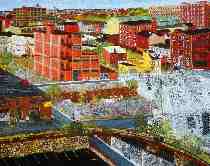
I met with Sarah McEneaney on Feb. 17 to interview her for a Q&A for Philadelphia Weekly. McEneaney’s glorious retrospective is upstairs at the ICA until April 4. The interview is up now at the Weekly’s website. [Ed. Note: Philadelphia Weekly’s online archive does not go back to 2004.]
Here is the complete version. (top image “Callowhill Neighborhood”)
Q. Your show as a whole seems cinematic. You have close-ups, wide angle landscapes, scenes of mystery, scenes pregnant with expectation or anxiety. The “No Title” picture (of the critic in the dark suit) is very Hitchcockian.
A. I definitely think about stories because I am chronicling my life. I never thought of it as cinematic…
Q. Architectural space is important in your work. You connect with it in a direct way. Does this come out of your work as a carpenter?
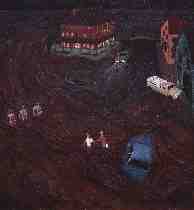
A. You know I used to support myself as a carpenter. Right out of art school, instead of waiting on tables I became a helper to Dick Caswell. He was an artist who supported himself by carpentry, so I helped him. I learned on the job. I did wait on tables a little bit when I was in school but I saw the advantage to learning a trade.
I also did art installation. When I got out of PAFA (Pennsylvania Academy of the Fine Arts) I worked as a preparator at PAFA. It was my first museum job. They hire artists because artists are careful with art. Then you learn on the job. (image left “Flood”)
Q. Are you still working as an art installer?
A. I haven’t worked [as a preparator] at the ICA for a year. Since having a gallery in New York, I’ve been selling enough to support myself.
Q. How did you get the New York gallery?
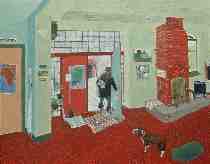
A. I went to an opening at Gallery Joe. It was Jacob El Hanani’s. Steve Schlessinger was there. He knows Jacob and had just been to the PMA (Philadelphia Museum of Art) and saw my picture there (“Winter Studio”). I met him and he said “[Your] name’s familiar.” I told him I was in a group show in New York the next week (at Dorsky Gallery). Steve and Jacob came to the opening. I showed him the brochure from my Swarthmore show and he looked at the swimming pool picture (“Revenge Fantasy”) and said “I want that one.” He bought it just looking at the brochure. I called Becky [Kerlin of Gallery Joe] and asked whether he was on the up and up. She said yes.
Q. Tell me about the group show at Dorsky Gallery. (image right “Winter 1996”)
A. Michael Klein used to have a gallery. He put me in some group shows. Now he’s the curator of the Microsoft Collection. He put two of mine in the collection. He’s a real supporter.
Q. What paintings are in the Microsoft collection?
A. He took “Men at Work” a neighborhood scene with guys drinking coffee on the ground and one guy up in a cherry picker working. He also took the painting I did of my mural on Diamond St.
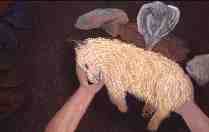
Q. I noticed that doors are big in your paintings. they’re usually open except for the backyard painting. Also there are no animals in that work.
A.Usually the doors are open. The studio spills into the house and the house into the studio. The door to my yard used to be always open. That changed. The door closing is about protecting myself and my home. It’s about that. There’s a peephole in the door and I have my hammer and my telephone.
The reason there are no animals is that my dog had died six weeks before. I think it wouldn’t have happened [the rape by the intruder] if I had a dog. Then somebody’s dog slipped into my yard and chased my kitty into a corner and chased the kitty away. She never came back so I had no animals at the time. (image above left “Alpha Dog”)
The next animal I got was Birdie. She was found on a street in Fishtown. I got her in Sept. I named her Birdie because she’s got a shadow marking of a bird on her head. It’s like the shadow of a bird flying over. I’ve had her five and a half years and she was one and a half or two when I got her.
Q. Let’s talk about paint and color. You use a lot of white in your works. Is white a nicer pigment to work with…talk a little bit about your eggs and pigments.
A. Titanium white needs more eggs. I never use zinc white. I never use black. A teacher, Cynthia Carlson, who I love, said black paint makes a hole. Mix it instead.
Q. How many eggs do you go through per painting or per week or however you can parse it out?
A. I can’t really break it down by painting because I work on more than one at a time. A two-egg day is a very full day of work. The eggs go far.
I mix it on a glass palette and sometimes if I’m mixing up more I can put it in the fridge and use it the next day. I have to separate the yolks from the whites. then I puncture the sacks and only use what’s inside. The sacks and whites get fed to Birdie. I cook them in the microwave and put em in with her kibble. Kind of like scrambled eggs.
I like to work on a number of things [at the same time]. They start out very loose — on gesso – it’s very absorbent.
Q. Gesso? I read some people use 10 layers under egg tempera…
A. I use six coats of gesso. I’ll spend an entire day prepping a 4 by 8 ft. sheet of plywood. It’s birch plywood. It’s furniture grade. One-half inch thick. Some of the bigger pieces have quarter inch thick and have more support on the back.
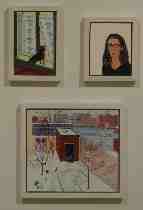
Q. Who’s your lumber purveyor?
A. Riley Lumber. I was just there this morning. I got half in birch plywood. I used to have a pickup truck. Now I have a Subaru…I have them do preliminary cuts [at Riley – so she can get them home] John Struble a furniture maker in my neighborhood has a table saw. I’m going there this afternoon. (image right ICA installation shot)
Q. I’m always surprised at the scale of your works. How do you decide the size…small vs big?
A. I guess I like to do the big neighborhood paintings and want to do them big. I have favorite proportions – three ft. by four ft. I like squares. Two ft. by two ft. Sometimes it’s arbitrary. I did a lot of eight-and a half inch by eleven inch head self portraits. …It’s the daily business. How we’re always putting out our resumes.
Q. Your patterns are incredible and you must love bricks. They’re all over the place.
A. I love bricks. I love them because they’re red. And I love the pattern of them. I may use a ruler pencil line then do them by hand …
Q. Do you do sketches first?
A. I do sketches for everything. My favorite sketchbook is the Strathmore six inch by eight inch. I do the drawing and project on the panel. Then of course there’s always changes.
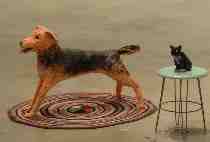
I used to spend hours translating from small to big. I like the dumb-math kind of thing. I like the variety of jobs involved.
Q. Tell me about your new neighborhood activism project
A. John Strubel and I formed a committee to save the Reading Viaduct. It’s the elevated tracks of the Reading Railroad. We want to turn it into a walkway. We got Inga Saffron up there walking with us. It’s the Reading Viaduct Project. Some Penn students did a charette about it recently. I’ve painted some of it in the neighborhood paintings. I think now it’s going to become the focus.
Q. How do you get those birds-eye shots of the neighborhood?
A. Like in Callowhill neighborhood? I went on the roof of a building.
Q. Do you use photos as sources?
A. I use photos when I don’t know how to do something. Like horses – I went on the Internet and found pictures. (above and below are installation shots of animal sculptures)
Q. Have you ever painted a scene with a big crowd? Most of the time it feels like it’s just you and the world…or you and a friend or sister and the world. I guess it would have to come out of your being in crowds…like at meetings for stopping the stadium?
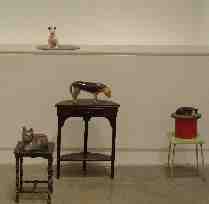
A. The summer of the stadium I didn’t get much painting done. I was so obsessed with the meetings and such. But I’m thinking of a painting…it’s in a travelling show next year, “Inside Out loud – Women’s Health”. (it’s not in the ICA show). I used to be a clinic escort at Planned Parenthood. This painting shows four escorts, maybe four people getting escorted in and a group of protesters.
Janine Myleaf an art historian at Swarthmore curated the show. It’ll be at Washington University in Jan. 2005. Janine wrote about self examinations in the ICA catalog
Q. It sounds like you were a baby boomer activist…like all this community work is in your blood (image below “No Stadium”)
A. I’m on the end of it. The last year of high school I was going to antiwar demonstrations. I couldn’t wait to be old enough to vote. My mom was a liberal. I just feel it’s part of living. I can’t imagine not doing it.
Q. Did you always know you wanted to paint?
A> I was painting in oils in 4th grade. 4th – 12th grade I was in a class. The teacher taught us oils.
Q. You were painting narrative paintings at a time when everybody else was painting abstract or minimalist things.
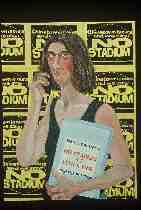
A. I think I made one abstract painting in high school and it wound up with a face in it. At PCA [Philadelphia College of Art, now University of the Arts], I took what you had to take. By the time I got to the Academy, I was painting from life. I already knew what I wanted to do….I painted that picture it’s in the catalog [it shows Sarah in a painting class at PAFA]. It has some messy abstract gestural stuff. By the time I got out I was making big collage paintings..they’re not that different from what I’m doing today.
Q. How do you feel being paired by ICA with Nara?
A. I like the big bowls with the cloth, and some of the drawings. I like the flying nun. Of course how could I not love his dogs.
Q. It seems there are lots of people painting from their lives now. Do you feel kinship with any of them?
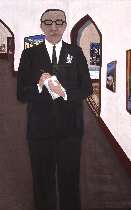
A. I love Shazia Sikander and also Amy Sillman. It’s totally different work but it’s similar in that its describing their world. (image right “No Title”)
Q. Your trip through the world is not like the trip of an Everywoman
A. Yes, but I’m a bunch of them. Astrid Bowlby sent me a real nice email and told me ‘when I stand in front of your paintings I think of me in the kitchen or me in the studio.”
Q. Tell me about self inflicted portrait. Did you paint it with your left hand?
A. No, I used my right hand. I was looking in the mirror. Sometimes I make the correction, sometimes I don’t. There’s one painting – it’s not in the show-where I’m sitting in a chair with a utensil in each hand and there’s one in my hair and behind my ears etc.
Q. Tell me about your art collection. I know you’re a great buyer of local art.
A. I tend to buy small things. I buy here. I bought a Susan Hagen…I just had to have it. I have made a lot of trades. I’m on the board of Vox Populi. I stay really attuned to what they’re doing.
Q. Were you ever in one of those co-op galleries?
aA. I was in 3rd St. gallery right out of school…when it was a women’s coop.
Q How was it working with the ICA on your show?
A It was a pleasure. When it came time to choose, I worked with Ingrid [Schaffner] and Elyse [Gonzales] and we sat around and talked and looked and ideas of themes became apparent and then there were too many. I didn’t’ know which ones to choose. I was too close to it. There were some very logistical things. This painting? iI’s in germany, so let’s not.
Q. Any travel plans?
A. I applied to the Tyrone Guthrie Center in County Monaghan, Ireland. If I don’t get in I’ll apply elsewhere. I’m a big believer in perseverence. (laughs)
Q I know you’re a person who likes details. I wonder if you have this one in mind? How many paintings have you made? It seems you’re a hard worker and prolific. (image left is wall of drawings at ICA)
A. Let’s see. It’s 25 years since I’m out of school. Say maybe 20 a year, maybe 15. Some years I’m more prolific than others… (25 yrs X 20= 500; 25 x 15=375; 25 x 10=250)
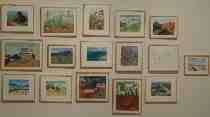
Q. Do you miss the art installing work?
A. The carpentry I was happy to back off of. I have back trouble. But I miss the great people I worked with.
Q. Your works have a kind of poetic distancing I think of when I think of Emily Dickinson. Emily and her encounter with a bird on the walk; Emily and her cottage; Emily and her garden wall; Do you write poetry? Do you read Dickinson?

A. I don’t write poetry. I’ve read Dickinson, some. It’s interesting you say Emily Dickinson. Jeanne Nugent mentioned her in something she wrote about a show I had at More Gallery.
But I loved writing the obit for Trumpet that’s in the catalog. I read obits every day. There’s a style to it. They tell about people’s accomplishments and their lives.
Q. Are there any paintings you woudn’t sell?
A. Trumpet. [“Alpha Dog”] I wouldn’t let it go. Also “Flood”…and Sozanski [“No Title”]. I’m keeping that one.
Q. So what do you leave out of your work? You put so much in…what’s not in there? (bottom image is detail of bricks in “Winter 1996”)
A. While they’re very specific, they very edited and controlled. I put something in that I want to for a reason. They’re not “tell all” paintings.
Q. I loved the sculpture on the small furniture borrowed from your friends.
A. They’re funny little sculptures. I hadn’t really showed them much. Nobody wanted to put them on pedestals. I live with them on funky little furniture. But I didn’t have enough.
I’m a fanatical knitter. I made all the rugs. I make them big then “felt” them. You wash them and dry them in the drier and they shrink.
Q. Finally, those gouaches…they seem like cinema out-takes.
A. I do gouaches when I travel. I always start them on site. And usually finish them on the trip. I never touch them when I’m home.








